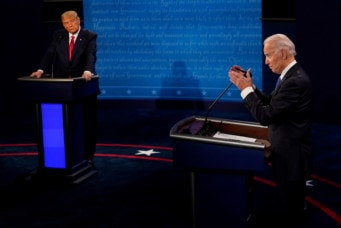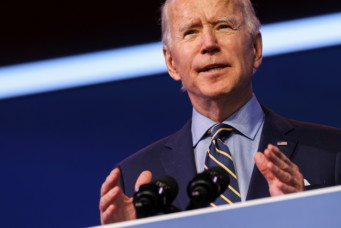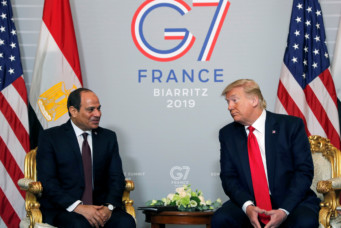Round Two: Trump’s Foreign Policy Takes on New Challenges
Trump will have to manage the continuing conflict in the Middle East, the war in Ukraine, and the rising power of China as he navigates the beginning of his second term

Throughout his career in politics, U.S. President Donald Trump has made his unpredictability an asset. One never quite knows if he will come across as an isolationist, calling for an end to “forever wars”, or a belligerent interventionist, threatening enemies with dire consequences. Some see him mostly as a “deal-maker”, ready to talk to friends and adversaries as long as there is a good bargain to be had. This would suggest that Trump is a “transactional” and pragmatic politician behind all the bluster and rhetorical excess. One thing is fairly clear, however: Trump does not bother with grand strategic concepts. He is not particularly well informed about international affairs and has little patience for endless rounds of diplomatic bargaining. He engages with other leaders with the promise of quick results, but may then lose patience or interest when the bargaining drags on.
Although many in his own Republican party have flirted with a “neo-conservative” view that the United States can only assure its preeminence in the world if it manages to export democracy and liberal values—while at the same time maintaining vast global military power—Trump does not share that frame of mind. In his first term, he was eager to court North Korea’s leader, Kim Jun-un, Russia’s Vladimir Putin, and any number of other non-democrats. It often seemed as if he preferred to deal with them more than with his NATO allies, most of whom were democratically elected.
In his first term as president, 2017-2021, the closest he came to a consistent policy was in his unwavering support for Israel. During those four years, he favored large aid packages for Israel, agreed to move the U.S. embassy from Tel Aviv to Jerusalem, recognized Israel’s annexation of the Syrian Golan Heights, restricted dealings with the Palestinian Authority, and tried to promote a series of bilateral Israeli deals with Arab countries such as Morocco, Sudan, the UAE, Bahrain and Saudi Arabia. The resulting “Abraham Accords” offered nothing to the Palestinians.
Trump’s other notable policy in his first term was to withdraw in 2018 from the carefully negotiated Joint Comprehensive Plan Of Action (or JCPOA) with Iran, which was designed to limit its nuclear capabilities in return for relief from economic sanctions. The agreement had been supported by all the permanent members of the UN Security Council, as well as the European Union. But it had weak support in the U.S. Congress in large measure because of Israel’s strong opposition to it. Trump’s successor, Joe Biden, chose not to rejoin in January 2021 when he became president. As a result, Iran has been seen by both Republicans and Democrats as one of America’s primary adversaries. During her brief presidential campaign in 2024, Vice-President Kamala Harris identified Iran as America’s most dangerous enemy.
A rather different set of international issues from those he faced in 2017 has confronted Trump in his second term. The war between Russia and Ukraine has entered its third year, and Trump has signaled that he wants to bring it to an early end. His explosive meeting with Ukraine’s president Zelensky in late February 2025 indicated that he is no longer willing to pour in large amounts of military aid to Ukraine and is hoping to pass on more of the responsibility for helping Ukraine to the Europeans.
While Trump has implied that he will quickly settle the Ukraine crisis, his dramatic encounter in the Oval Office with Ukrainian President Zelensky raised more questions about next steps than it answered. Obviously the chemistry between the two leaders is at an all time low, and Trump appears to be signaling the possibility of ending the large amounts of military support that has been going to Kiev.
In the Middle East, Trump has thus far shown remarkable support for Israel’s continuing campaign to crush Hamas, while keeping up some diplomatic efforts to lower the temperature in Gaza, encouraging the exchange of hostages and prisoners, but refraining from exerting any real pressure on the Israeli government. With respect to Iran, there have been mixed signals, with Trump signing on to tough sanctions while publicly expressing some ambivalence about doing so. Where he will come out on policy toward Iran remains an enigma, but he may take some cues from Saudi Arabia, the one Arab country that he seems to pay attention to. Thus far, he has given few hints of what policies he might adopt toward other regional powers such as Turkey, Egypt, and the new regime in Syria.
As for the ongoing crisis between Israel and the Palestinians, Trump has delegated the task of lowering the temperature of the conflict in Gaza and facilitating the exchange of hostages and prisoners, but has also raised widespread concerns by floating dramatic suggestions of transferring Palestinians from Gaza and radically rebuilding the area as a high-end tourist destination—just what one might expect from a real-estate magnate. Whether behind this ridiculous rhetoric there is any real intention of trying to find a viable political path to Arab-Israeli peace remains a very big unanswered question.
In true Trump style, he has given mixed signals about Iran. On the one hand, he has maintained harsh sanctions on the country, while expressing some ambivalence about doing so. He has also enlisted his new “best buddy”, Elon Musk, to open a discreet channel of communication to the Iranians. As for the evolving crisis in Syria, Trump immediately posted his thoughts on December 7, 2024: “THIS IS NOT OUR FIGHT. LET IT PLAY OUT. DO NOT GET INVOLVED.” With more than 1000 American troops in Syria, that may be easier said than done.
Then there is the challenge of dealing with China. Many American strategic thinkers believe that China represents the major challenge to American power in the future. It has great economic strength, growing influence in many parts of the world, a powerful military—including nuclear weapons—and has, under President Xi Jinping, adopted a newly belligerent stance toward Taiwan. Trump has met with Xi on several occasions; instead of favoring diplomatic engagement with China, he seems to think that his first priority toward Beijing should be to impose tariffs on Chinese exports to the United States, an action which is as likely to harm American consumers as it is to affect China’s economy. Perhaps Trump will rethink his fondness for tariffs if he listens to Musk, who has publicly described himself as “somewhat pro-China”—no surprise, given his huge economic stake in the Chinese economy. And Trump has also given signals that he is willing to meet soon with Xi Jinping, so diplomacy is still a realistic option for his dealings with America’s most significant adversary.
Finally, Trump will have to devote some attention to European allies. Many of them are wary of his apparent skepticism about NATO and the European Union. With recent developments in the Ukraine crisis, it is increasingly possible to imagine a significant divergence between most of Europe and the United States over significant international issues, a major change in the post-world War II international system if it does take place.
All the President’s Men and Women
One of the surprises in the immediate aftermath of the election on November 5 was how swiftly Trump began to announce his choices for key positions in his cabinet and in other influential positions. The speed with which he started to assemble his government is understandable—because of the nature of the American political cycle, Trump has about two-years in which to carry out his most ambitious projects. He will have the advantage of a House and Senate under Republican control, but he must be aware that midterm elections in 2026 could change that balance significantly. And since Trump will not be able to run for a third term, by 2027 he will enter the “lame duck” phase of his presidency, a period that is rarely marked by new initiatives or major successes. In short, if Trump is to make his mark on both domestic and international affairs, he must choose his priorities carefully and move quickly.
For Secretary of State, he named Marco Rubio, a senator from Florida since 2011, with strong views on Cuba, Iran, Israel and China, but little real experience in the conduct of foreign policy. For Secretary of Defense, he selected Pete Hegseth, a TV personality with some military experience, but nothing that would suggest he will know how to manage the enormous bureaucracy of the Pentagon and its huge budget. He named Tulsi Gabbard—a former Democratic Congresswoman from Hawaii, who earned some notoriety for meeting with Syrian President Bashar al-Asad in 2017, and for sharing Trump’s interest in trying to cooperate with Russian leader Vladmir Putin—as head of National Intelligence. In addition, his Vice President, JD Vance, is apparently being given a larger role in foreign policy than one might have expected, as was demonstrated by his active participation in the humiliation of Ukraine’s president on February 28.
John Ratcliffe, a former Texas Congressman with intelligence experience, was his choice for Director of Central Intelligence. A surprise nomination for the United Nations position was Congresswoman Elise Stefanik, an ardent supporter of Israel. Other strong pro-Israel voices are Mike Huckabee, his choice to be Ambassador to Israel, a former Governor of Arkansas, and an outspoken advocate of the Greater Israel agenda. Trump also named Steve Witkoff, a businessman with close ties to Israel, as his envoy for Middle East diplomacy, and apparently a trusted envoy for other missions as well. And we can expect Trump to rely on his son-in-law, Jared Kushner, to deal with the Saudis and Emiratis, and his son Donald Jr. to keep his father’s political and financial interests at the forefront of policy concerns.
There will doubtless be other individuals who play important roles in Trump’s inner circle on foreign policy, such as Mike Waltz, a former Florida Congressman whom the president has chosen to be his National Security Adviser. Waltz is outspokenly hawkish on China, but less so on support for Ukraine. He and his National Security Council staff will have the advantage of proximity to the President, but that is no guarantee of influence. We know from Trump’s first term that he is quite ready to replace people who do not suit his idiosyncratic style. He had four different National Security Advisers in his first term, an unusually high rate of turnover.
Likely First Decisions
From the brief overview presented here, there is no certainty about the direction Trump’s foreign policy will take. But let me make a few guesses based on indicators that we already have. First, Trump will try to bring the war in Ukraine to an early end, but his dramatic clash with Ukraine’s president suggests that it will take some time to get any kind of diplomatic effort on track. What is clear from Trump’s early actions is that there will be no effort to prolong the war as a form of pressure on Russia. In fact, Trump seems to be eager to meet with President Putin in the near future and even to begin long-overdue talks on nuclear arms reductions.
A second priority will be to engage with China on a wide range of issues. Economic pressure may be one tool, but will certainly need to be reinforced by effective diplomacy. For the moment, there is no one in Trump’s entourage other than Musk who might play a role in easing tensions. But Trump is enough of a realist to see that a one-dimensional policy of economic pressure on China will not produce good results, and could also be costly to the United States. So he will, at some point, have to engage in “deal making” directly with President Xi, for whom he seems to have considerable respect as a fellow “strong” leader.
Based on much of what Trump has done and said in the past, one might expect him to adopt a very hostile position toward Iran—and that may, in fact, be what happens. But I suspect that Trump will be hearing from a number of sources, including Gulf Arab leaders, that Iran may be ready for an easing of the extremely hostile relations it has maintained with most of its neighbors in recent years. The current Iranian president has certainly been sending signals of a willingness to engage in some level of diplomatic contacts with the United States, and I would not be surprised if Trump shows some interest. This, of course, would be strongly opposed by his Israeli friends, but there has already been one meeting between Musk and Iran’s ambassador to the United Nations in mid-November 2024 that is suggestive of a mutual interest in defusing tensions.
And that leads me to my concluding comments about the U.S.-Israeli-Palestinian set of issues. Trump has certainly established his reputation as an ardent supporter of Israel. But he also apparently wants to see an end to the high levels of violence in the Middle East. This should lead him to try to try to end the current Israeli-Palestinian hostilities and to endorse a broader diplomacy designed to reduce regional tensions. A benefit of such an approach, if successful, might be a lowering of the price of oil. Trump would be happy to take credit for such a development. But there is no indication that he has internalized the need for a sophisticated, complex, multilateral approach to finding a way to resolve the core Israeli-Palestinian issue that was the proximate cause of the October 7, 2023, explosion and its aftermath. This would require statesmanship of the type exhibited by Richard Nixon, Henry Kissinger, Jimmy Carter, Cyrus Vance, George H. W. Bush, and James Baker, to name a few. Alas, that does not seem to be in the cards, at least as far as I can read them.




